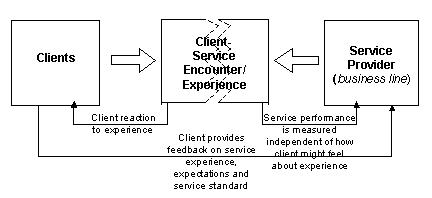Common menu bar links
Breadcrumb Trail
ARCHIVED - Summary Report on Service Standards
 This page has been archived.
This page has been archived.
Archived Content
Information identified as archived on the Web is for reference, research or recordkeeping purposes. It has not been altered or updated after the date of archiving. Web pages that are archived on the Web are not subject to the Government of Canada Web Standards. As per the Communications Policy of the Government of Canada, you can request alternate formats on the "Contact Us" page.
3. What are Service Standards
Service standards have been incorporated into the management of many government programs in many countries. Although there may be nuanced differences among jurisdictions in how they define or use service standards, the following common themes permeate, although the client focus is clearly paramount:
- client focused, including consultation with clients in setting the level of service or service standards
- publicly indicate the level of service that clients can expect in a service experience
- incorporate measurable performance objectives or targets directed to satisfying clients
- reflect a commitment by the organization providing the service
- front-line staff who actually provide the service should be consulted in setting service standards
- both clients and staff have the same understanding of the level of service that clients should expect
- incorporate a complaint and redress mechanism to clients if the service standards are not met
- usually relate to timeliness, accessibility to the service, interactions between staff and clients, accuracy, reliability.
For the federal government, the Treasury Board Secretariat's How-to Guide says "Service standards are a commitment by the organization to provide a certain level of service to clients. These are usually in areas such as communications, access timeliness, interactions between staff and clients, and costs ... consistency counts ... service standards must incorporate performance objectives ... important tools for managing client expectations and should reflect the available resources."[9]
The How-to Guide then describes the elements of service standards:
- a description of the business line,
- service quality pledges or principles,
- performance objectives,
- cost of delivering the service, and
- a clear complaint and redress mechanism.
Service standards are defined around an interactive process, in the sense that there is a service provider and a service receiver or client. A service deliverer may establish a service standard to better manage client expectations with the intent of increasing client satisfaction with the service. The standard may be, for example, telephones should be answered within three rings or less, or staff to be more courteous to clients. In the former case, the rings can be monitored and action taken to achieve the standard. In the latter case, some form of client comment card or client feedback (e.g., survey, focus group) can be used to determine how courteous the client found the staff.
In each case, a service standard has been initiated and performance measured against the standard. One relies on the client input, the other on independent measure. Even quantifiable standards must be gauged against the client's reaction to the encounter or experience. The client may be satisfied with two rings, or four rings. The standard should reflect the client's views. (See Figure 2)
Figure 2. Client/service deliverer interaction in service standard development
 A good Service Standard is sensitive to the
wants and needs of the client, but also mindful that the standards must be
attainable within existing resource, regulatory and policy constraints.
A good Service Standard is sensitive to the
wants and needs of the client, but also mindful that the standards must be
attainable within existing resource, regulatory and policy constraints.
Since client needs and expectations may change, service standards will change to reflect the new priorities of the client. The client's reaction to service encounters or experience with the service deliverer must be monitored to maintain acceptable service levels.
